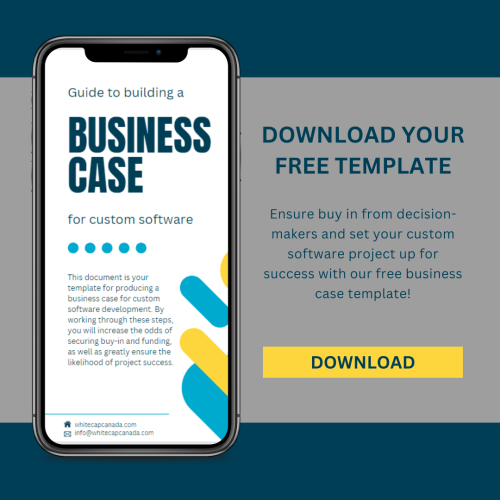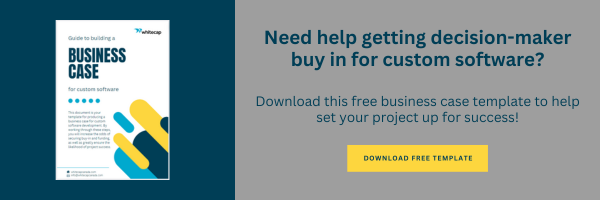So, here’s the paradox: organizations understand that to stay ahead of the curve requires embracing technological advancements, but convincing stakeholders to invest is a challenge indeed. We often hear that software budgets are down, and those with their hands on the purse strings are cautious due to economic concerns.
Getting your custom software project approved and off the ground can feel like an impossible task. From our experience, ensuring a successful outcome starts before the project even kicks off and can all boil down to how well you can build the business case for custom software.
That’s why we’ve put together this guide, as well as a downloadable template to give you an edge on how to effectively make the business case for implementing custom software.
The 8-Step Guide to Building the Business Case for Custom Software
Step 1: Identify the Business Need
Before any new technology is adopted, you need to know the current lay of the land. Start by describing the current environment and the desired future state. Articulate the business need, which could be a problem or opportunity – or both! You may want to pinpoint opportunities where custom software could unlock new capabilities, improve the customer experience, or gain a competitive edge in the market. Whether you conduct a SWOT, PESTEL or GAP analysis, this assessment will help you map out your pain points and establish your goals, priorities, and readiness for change.
Understanding your current software ecosystem is a key part of this stage. What software is being used throughout the organization? Understand hosting, integrations, licences being used, etc. Are there redundancies that can be addressed with a consolidated custom solution?
Organizational leaders sometimes choose to stick with existing software to avoid the risks and upfront costs associated with replacement. Make sure to document the key internal and external drivers of change. Internal drivers can involve system or workflow inefficiencies that impact productivity, a new mission or business imperative, the need to optimize employee skillsets or improve cross-functional collaboration. External drivers may include changes in regulations, consumer demand, competitive pressures, or industry change.
Pro Tip: Use visual aids like flowcharts or diagrams to illustrate the current state versus the desired state, which can help stakeholders quickly understand the gap and the necessity for custom software.
Step 2: Engage Stakeholders and Define Roles
If there’s one thing that cannot be underscored enough it’s this: people drive change. So, you need to get your key project stakeholders involved. The first step involves identifying, mapping and prioritizing stakeholders – these may include end-users, team leads and senior management. These stakeholders have a wealth of knowledge and experience that will help to show the potential organizational impact more clearly and build the business case.
Equally as important, by taking the time to involve stakeholders, you ensure that they are aligned with the strategic direction of the project, becoming internal champions who can boost the success of the project. One of the biggest derailers to any project is resistance to change, so getting buy-in is crucial.
Once the key project stakeholders have been identified and are on-board, create a shared doc that lists roles and responsibilities; not only does this ensure transparency, but it also keeps everyone aligned on who’s doing what. It’s important that every stakeholder understands how the issue impacts their department/function, what you want to achieve and how you’re going to get there. It’s also critical that everyone is cognizant of and committed to the time this new project will take.
One person should be assigned to be the project lead and main liaison between the custom software development team and the other project stakeholders. (Be sure to keep ALL stakeholders informed as the project progresses to keep them informed and engaged.)
Pro Tip: Utilize stakeholder feedback tools like surveys, discussion boards, brainstorming sessions or one-on-one meetings throughout the project to measure and adapt to stakeholder satisfaction and concerns in real-time.
Step 3: Establish Your Requirements
If you don’t have a very clear idea about the MVP (minimal viable product) you need to create to solve the problem, without a doubt, costs will balloon.
Focus on the “must haves” when establishing an MVP. It all starts with requirement gathering. You need to know the big picture and then really narrow that down to the essentials. Consider: what the software needs to do, integrations required, hosting and security needs, accessibility requirements, user experience, etc.
Bells and whistles can come later. The goal at this stage is to think about the minimum functionality your software needs to address the challenge and get your investors attracted.
Pro Tip Create a prioritized list of features and get it validated by end-users to ensure the MVP meets the most critical needs.
Step 4: Define Your Success Metrics
How will you measure success? Develop a concise but comprehensive list of metrics as the foundation of your business case.
Whether it’s streamlining operations, improving customer engagement, or driving up revenue, align these objectives with broader organizational goals and key performance indicators (KPIs). When you take a strategic approach to your KPIs, you make it not just about numbers but about real, meaningful change.
By establishing measurable outcomes that demonstrate the tangible benefits the new technology will deliver, you can more easily estimate cost savings, revenue growth, or increased efficiency. (Essential before moving onto Step 5!)
Pro Tip: Link each KPI to an actionable insight or decision to emphasize how tracking these metrics leads to improved business outcomes.
Step 5: Costs, Benefits & ROI – Oh My!
It’s the question every finance person wants to know: How much is this project going to cost? Even if you’ve never invested in custom software before, do some research to estimate the project costs. (Be sure to read our guide to planning and budgeting for custom software.)
One tack to take is to also look at the costs of NOT changing, which can be far greater than the cost change requires. If you don’t change, will maintenance costs skyrocket? Will customer satisfaction drop? Will competitors move ahead of you? Will you lose market share?
To get the green light for funding for your project, show the qualitative and quantitative benefits. How will a new solution benefit your organization? If one of your goals is to improve employee productivity, how will this custom software investment support you in achieving that? How does this improved productivity have a broader impact to your organization’s mission and bottom line?
Quantify the financial implications of custom software development by conducting a comprehensive cost-benefit analysis. Consider the estimated one-time implementation costs (development, licensing, training) and ongoing expenses (maintenance, support, upgrades). Compare these costs against the anticipated benefits, including increased productivity, reduced errors, faster time-to-market, etc.
In our Ultimate Guide to Custom Software, we outline some specific advantages of custom software that you can include in your analysis. A custom solution:
- Is tailored to your specific business needs, processes, and workflows, so you don’t have to alter the way you work to fit into the mold of a boxed solution.
- Can be built to integrate with your existing systems, meaning less redundancy and more productivity.
- Can be scaled up as your business grows and needs change.
- Can be built with multiple layers of security that make infiltration very difficult for hackers.
- Comes with the benefit of dedicated, reliable resources who can monitor, maintain and update your custom software application as needed.
- Is an asset on the company books. You own it, it’s a competitive advantage, sales driver and time saver.
When you can show the potential return on investment (ROI) over time as well as the project’s ability to contribute to the organization’s long-term success, the likelihood of budget approval is greatly increased.
Pro Tip: Be prepared to answer the question “Is there an off-the-shelf or SaaS solution that would do 85-90% of what we need to accomplish?” Do we want to own the IP or rent it monthly? You will have to make the case for why custom software is the ideal solution. Get some tips in our post How to Decide Between Off-the-Shelf and Custom Software.
Step 6: Assess Risks and Mitigation Strategies
When it comes to change, there’s always some level of inherent risk involved. Acknowledge and address the potential risks associated with implementing custom software, such as integration issues, user adoption hurdles, or project delays. If there are constraints, like limited IT resources, make sure to outline these as well.
Next, develop mitigation strategies to reduce these risks and demonstrate your proactive approach to risk management. Consider factors like scalability, security, and compliance requirements to ensure the long-term viability and success of the software solution. Create a high-level plan for proactively addressing these risks.
And don’t forget there are risks involved with keeping the status quo. Look at risk factors like the time, money and resources required if there is no custom software solution. What opportunities would be lost? Outlining the risks associated with staying as is can help sway key stakeholders to move forward with making the change.
Pro Tip: Arrange for early-stage testing with a pilot group to catch and mitigate risks related to user adoption and software functionality before full-scale implementation.
Step 7: Outline an Action Plan
You need to plan, implement, and monitor the proposed technology in relation to a clear and realistic timeline and budget. Clearly define roles and responsibilities, and establish how decisions will be made. Address how you will allocate resources effectively. From the kickoff meeting to user training, establish milestones and estimated timelines to track progress and ensure accountability.
Be sure to factor in any required internal change management needed to achieve your ROI. It’s always essential to acknowledge that any plan needs flexibility to adapt to any changes and adjustments based on feedback during the development phase.
Pro Tip: Position the implementation of custom software as a catalyst for fostering a culture of innovation and continuous improvement within the company. Highlight how embracing new technology reflects a commitment to staying ahead of the curve, driving digital transformation, and embracing change as a strategic imperative.
Step 8: Plan For the Future
It’s also important to remember that your custom software project doesn’t end after deployment. It’s crucial to monitor for continuous improvement like adding features, functionality, bug fixes and modernizing your application when the time comes. Plan for additional development phases as needed.
It’s important to plan for this from the outset as there will be ongoing costs involved. It’s not a set it and forget it situation.
Pro Tip: Establish a formal review process for the software at regular intervals post-deployment to assess if it meets business needs and to plan for upgrades or additional features regularly.
Get Your Template
Crafting a compelling business case for implementing custom software requires a strategic approach that aligns technology investments with organizational objectives, addresses stakeholders’ concerns, and demonstrates a clear path to value creation.
Download your free custom software business case template here.
How Can We Help You?
If you’ve got a software development project you’re considering, you need a partner who can help. We’ve got a proven approach, and the expertise leading businesses depend on to develop custom software applications that become core to their companies. Let’s chat.

